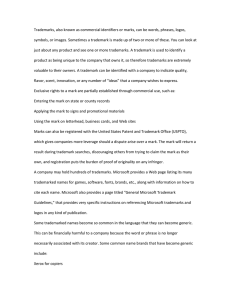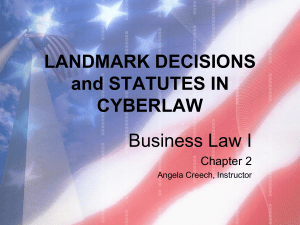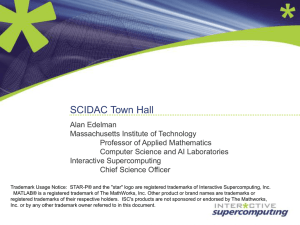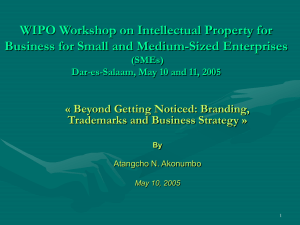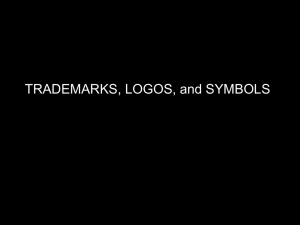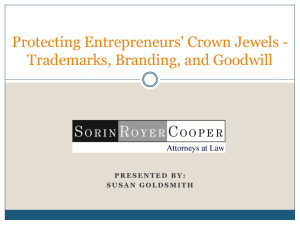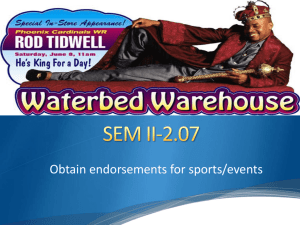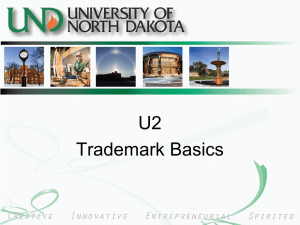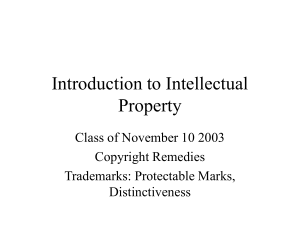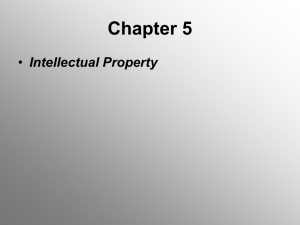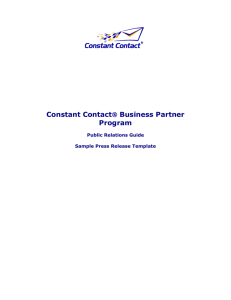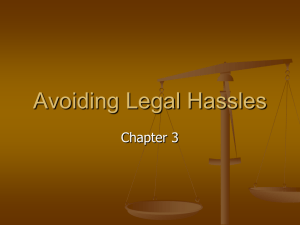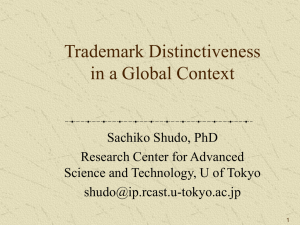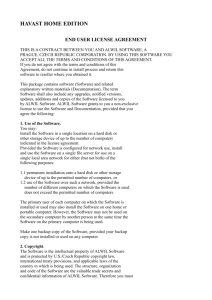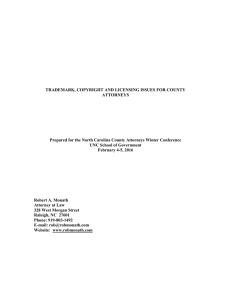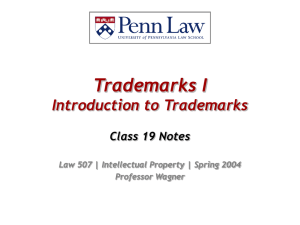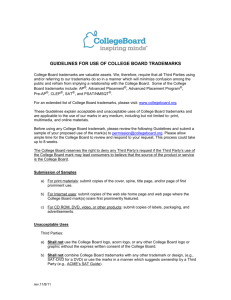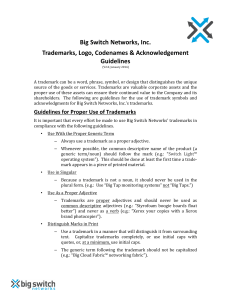Trademarks
advertisement
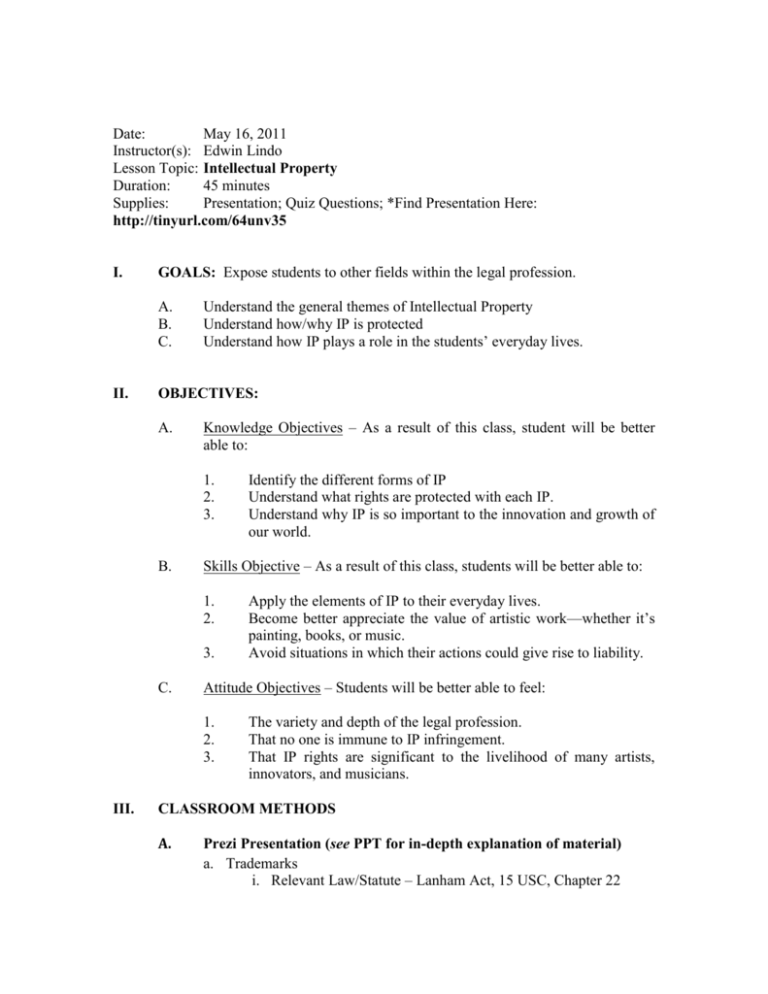
Date: May 16, 2011 Instructor(s): Edwin Lindo Lesson Topic: Intellectual Property Duration: 45 minutes Supplies: Presentation; Quiz Questions; *Find Presentation Here: http://tinyurl.com/64unv35 I. GOALS: Expose students to other fields within the legal profession. A. B. C. II. Understand the general themes of Intellectual Property Understand how/why IP is protected Understand how IP plays a role in the students’ everyday lives. OBJECTIVES: A. Knowledge Objectives – As a result of this class, student will be better able to: 1. 2. 3. B. Skills Objective – As a result of this class, students will be better able to: 1. 2. 3. C. Apply the elements of IP to their everyday lives. Become better appreciate the value of artistic work—whether it’s painting, books, or music. Avoid situations in which their actions could give rise to liability. Attitude Objectives – Students will be better able to feel: 1. 2. 3. III. Identify the different forms of IP Understand what rights are protected with each IP. Understand why IP is so important to the innovation and growth of our world. The variety and depth of the legal profession. That no one is immune to IP infringement. That IP rights are significant to the livelihood of many artists, innovators, and musicians. CLASSROOM METHODS A. Prezi Presentation (see PPT for in-depth explanation of material) a. Trademarks i. Relevant Law/Statute – Lanham Act, 15 USC, Chapter 22 1. Sets out the requirements of potential marks and rights of trademark holders to exclude others from use of the mark 2. Sets out a “Supplemental Register” for marks which could evolve into marks eligible for protection (Descriptive Marks) 3. Sets out remedies for infringement ii. Basic Examples of Trademarks 1. Nike, Just Do It, “UW” 2. Colors: Brown for UPS, Pink for Owens Corning Insulation 3. Sounds: MGM’s Lions Roar, NBC Chimes iii. Basic Policy of Trademark - protects the name or mark associated with the product to which they are attached iv. Trademarks are designed to protect consumers more than the trademark holder: 1. By preventing others from copying a source-identifying mark, 'reduce[s] the customer's cost's of shopping and making purchasing decisions,' for it quickly and easily assures a potential customer that the this item is made by the same producer as other similarly marked items that he or she liked (or disliked) in the past. Qualitex Co. v. Jacobson Products Co, U.S. Supreme Court (1995). v. Types of Trademark 1. Fanciful Trademarks - are "coined" terms that had no meaning before being trademarks. Exs: KODAK, STARBUCKS, VERIZON 2. Arbitrary Trademarks - are common words used in a unique way so that the word has no relationship to the product. Exs: APPLE and SUN for computers, AMAZON and YAHOO! For Internet sites, GREY GOOSE for vodka. 3. Suggestive trademarks - indirectly allude to a quality of the product. Exs: PLAYBOY for a men's magazine, JAGUAR and MUSTANG for fast cars. 4. Descriptive trademarks - describe the goods or service they market. Exs: HairCuttery for a place to get your hair cut, COMPUTERLAND for a computer store, VISION CENTER for an optics store. vi. Threats: 1. Genericide – When a successful mark loses its ability to identify a particular brand and becomes synonymous with the class of products a. Ex. – THERMOS, ASPIRIN 2. Trademark Dilution - When a famous mark loses its ability to identify a particular brand a. Ex. – Coca-cola Jeans, Rolls Royce Software vii. How to Protect Trademarks 1. ALWAYS use a trademark as an adjective a. Ex. LEGO toy blocks, AMSTEL beer 2. NEVER use trademark as a verb a. Ex. XEROXING(copy on Xerox copier), ROLLERBLADING 3. NEVER use trademark as a noun a. Ex. Take and ASPIRIN b. Copyrights i. Ask students: 1. 1. What do you think about when you hear the word “copyright”? a. Write down students’ responses on the whiteboard. Some examples include: movies, music downloading, Limewire/Napster. 2. 2. What are some famous copyrighted works? a. Write down students’ responses on the whiteboard. Some examples include: Mickey Mouse, Harry Potter, and a more obscure example, the “Happy Birthday” song. b. Play popular songs- (Jay-z, Michael Jackson, Kanye West) 3. 3. What happens to a person who violates someone’s copyright? a. a. Write down students’ responses on the whiteboard. Some possible answers include: pay civil damages (as in many file-sharing cases), pay a fine, serve jail/prison time. ii. What is a Copyright - form of protection provided by the laws of the United , States(Copyright Act of 1976) to the authors of “original works of authorship,” including literary, dramatic, musical, artistic, and certain other intellectual works. This protection is available to both published and unpublished works. iii. Basic Rights of Copyright Holder 1. 2. 3. 4. Reproduce work in copies and phonographs Prepare derivative works based on the work Distribute/Sell copies of works sale To display or perform work publicly iv. Term of Copyright – Life of author PLUS term of years (70 years in US) v. Basic Requirements of Copyrights 1. Only the author or person deriving rights from the author may obtain or use a copyright 2. Fixed Form - Work must be fixed in a tangible form of expression (paper, audio or visual recordings) 3. Copyrights are secured automatically when the work is created: No Publication or action of Copyright office is required to secure a copyright – But certain advantages of registering vi. What is Not Protected by Copyright 1. Works not fixed in tangible form (Ex. - choreographic works not notated or recorded) 2. Ideas, procedures, methods, concepts, devices, principles (Copyright covers expressions of ideas – Not the idea itself) 3. Titles, names, short phrases, slogans; familiar symbols; lettering or colors. This is what Trademark law is for. 4. Work consisting entirely of information that is common property & containing no original authorship (standard calendars, height/weight charts) vii. End the Class Talking about GIRL TALK (A DJ that uses 20 second segments of songs, mashes them together, and makes some pretty cool songs). There is huge controversy surrounding his music and the consequences of him not acquiring permission to sample each of the songs. 1. The presentation will have video/audio of Girl Talk. 2. Ask the students whether Girl Talk should have to pay for the samples. 3. Ask whether he has created his own copyrighted (creative work)? *remember, you can’t copyright other copyright protected work. How do we reconcile this? B. Homework: a. Have the students find a copyrighted work that they enjoy. Once they find it, record who owns the copyright.
